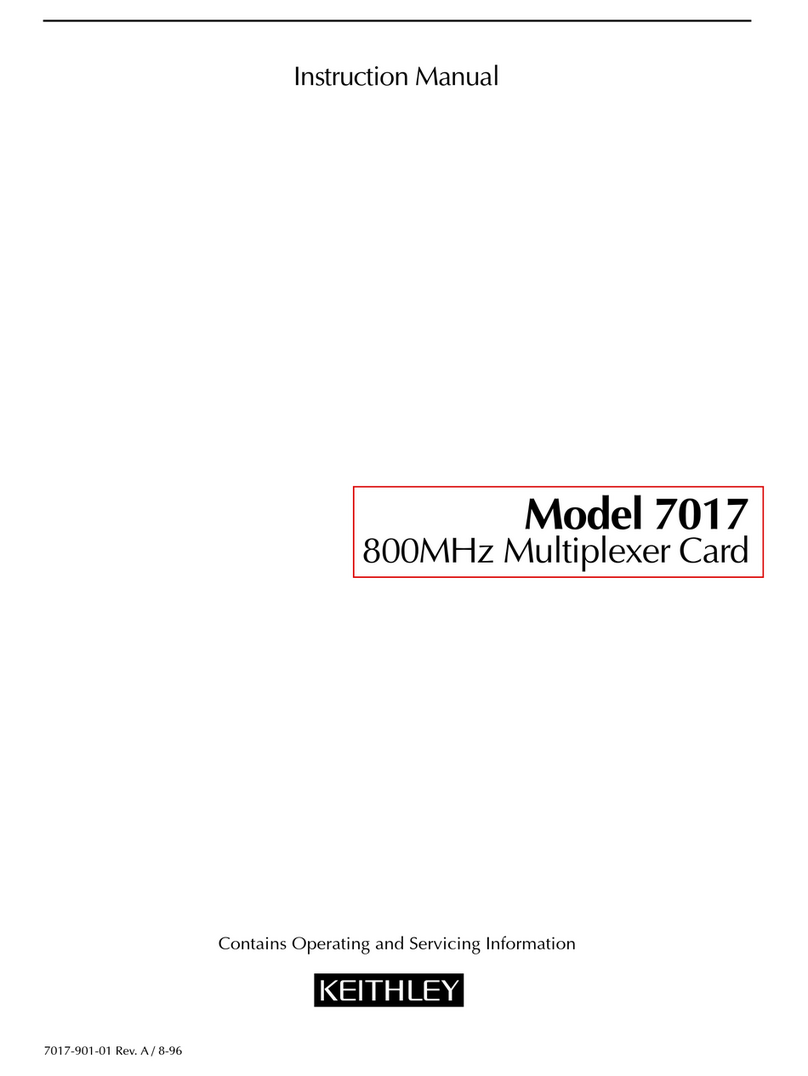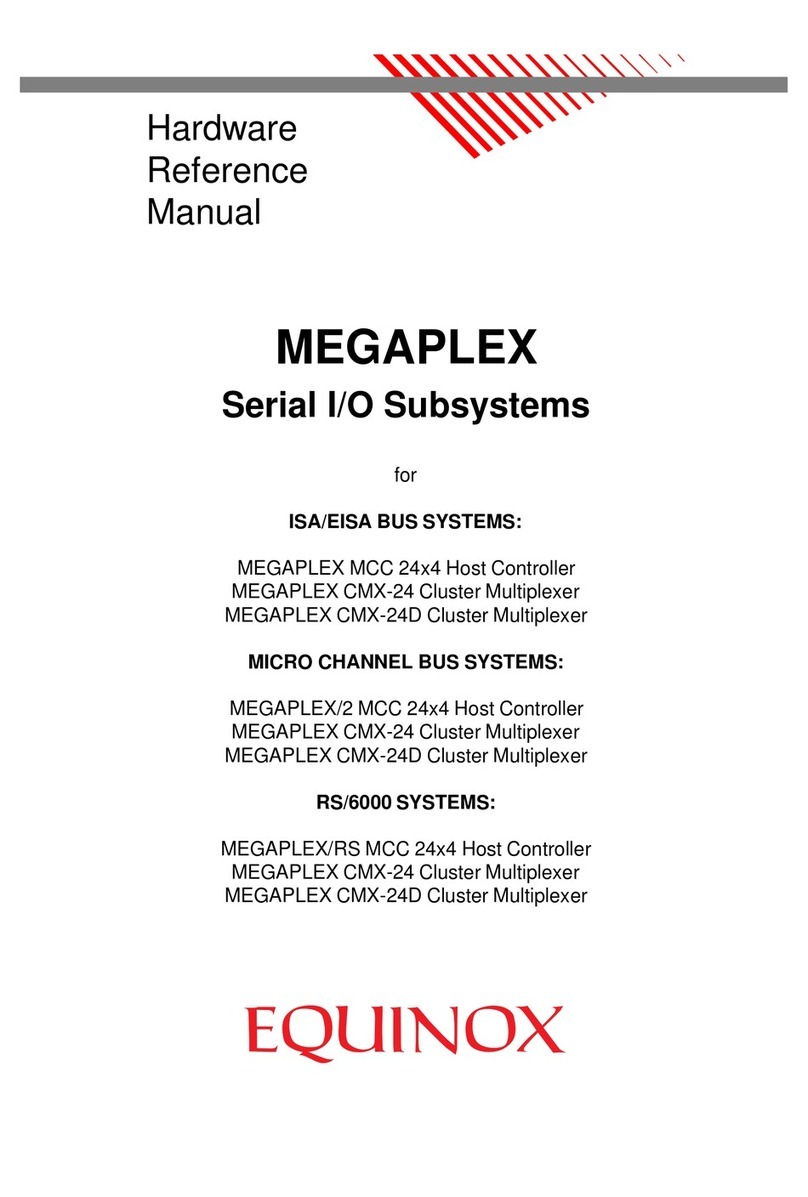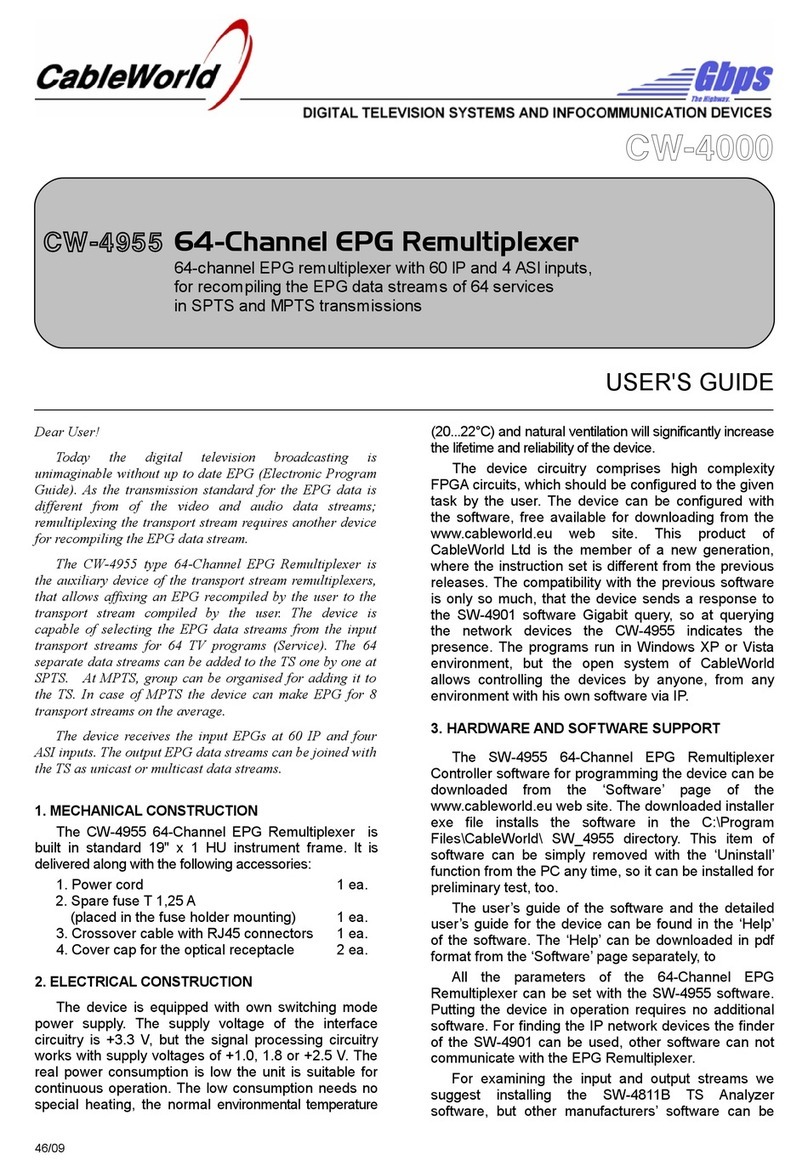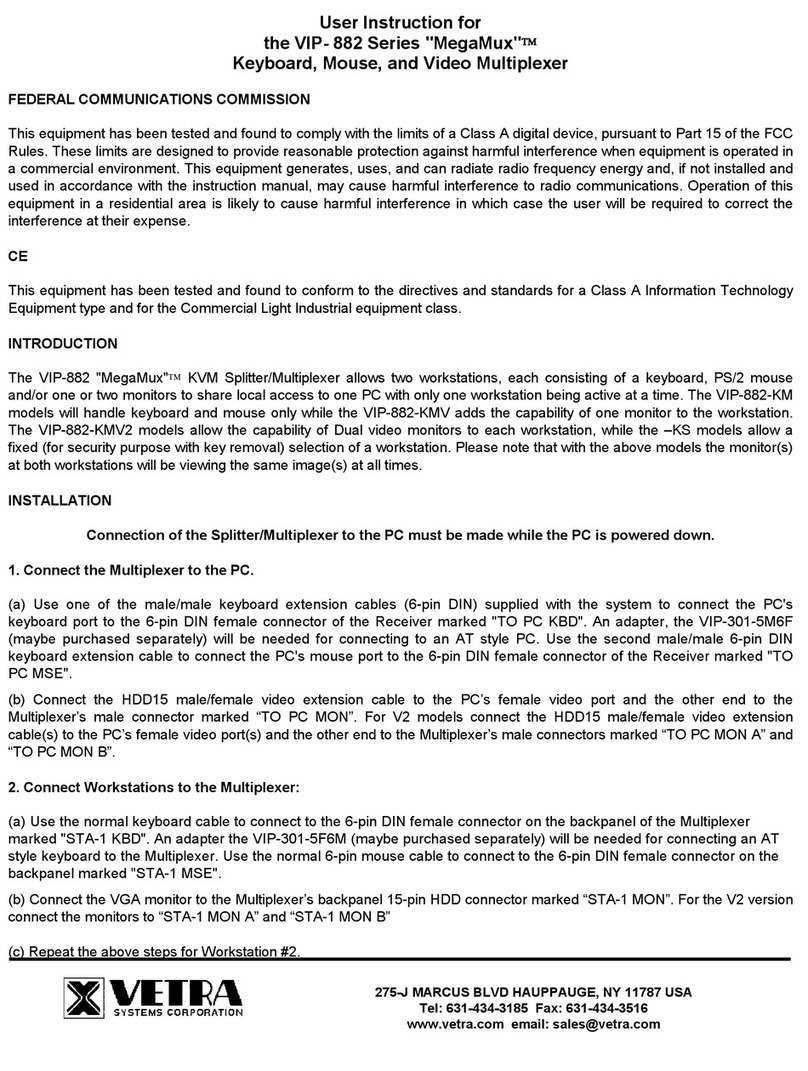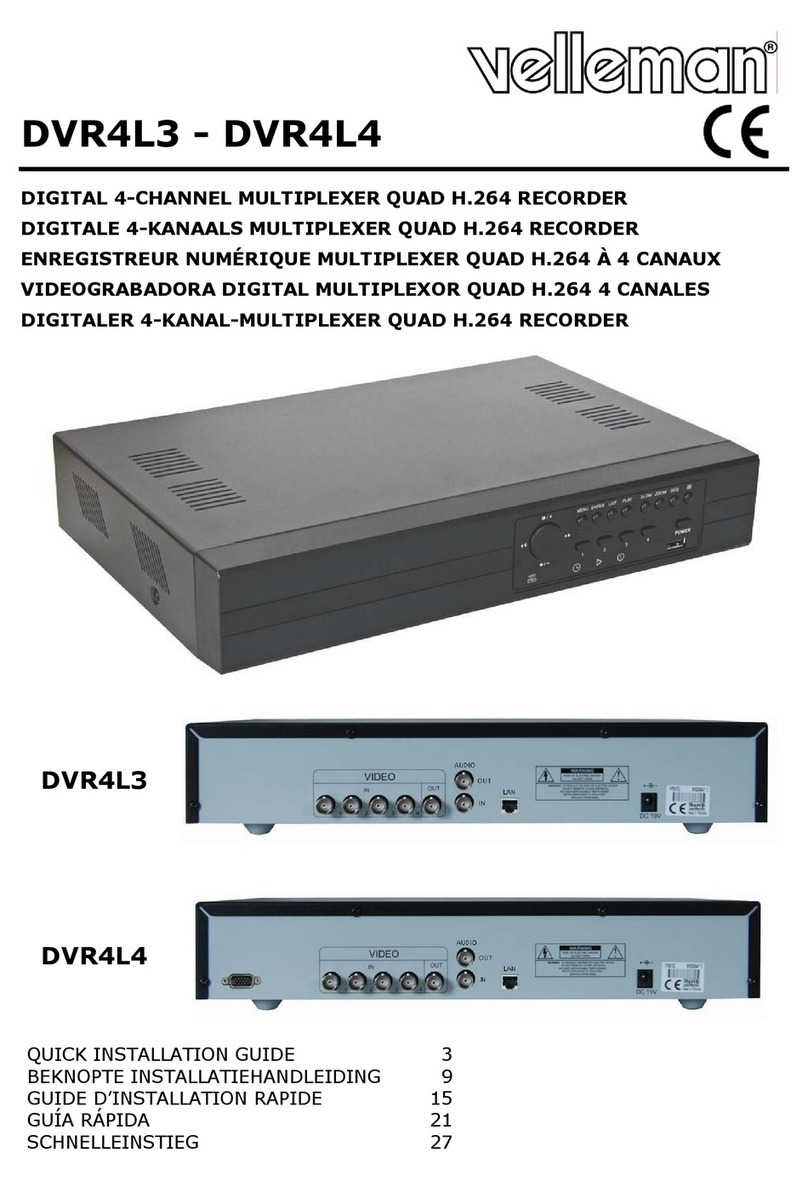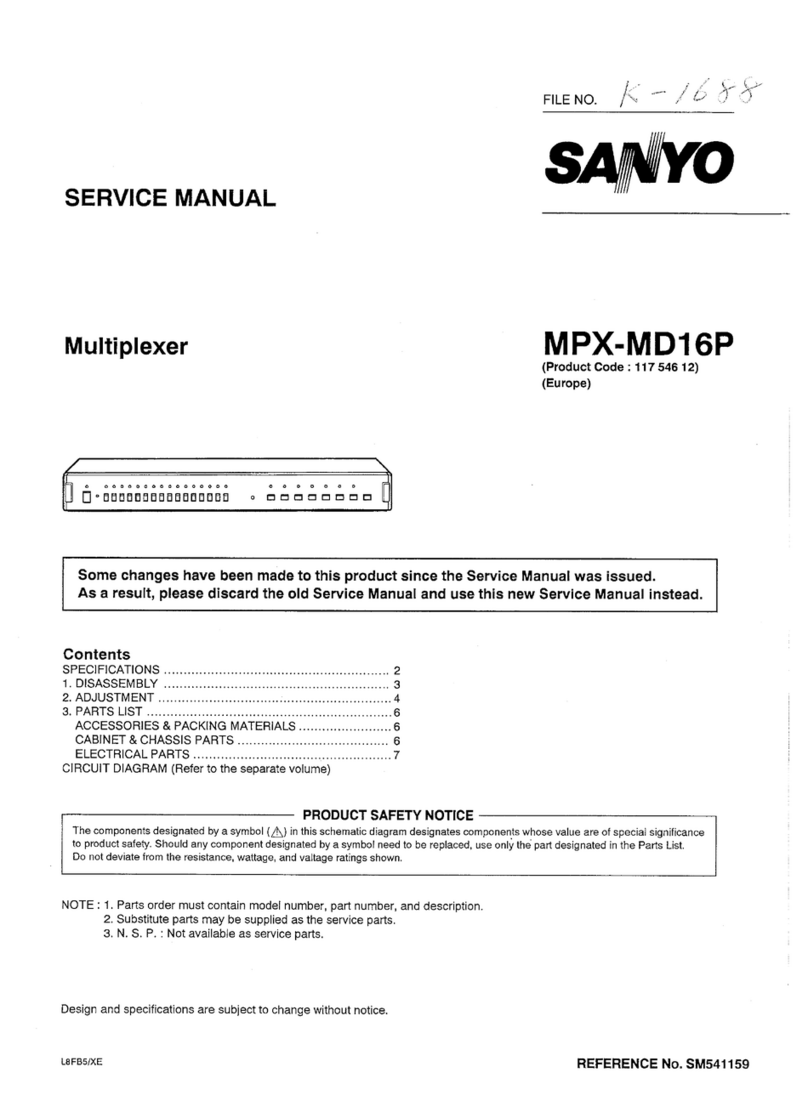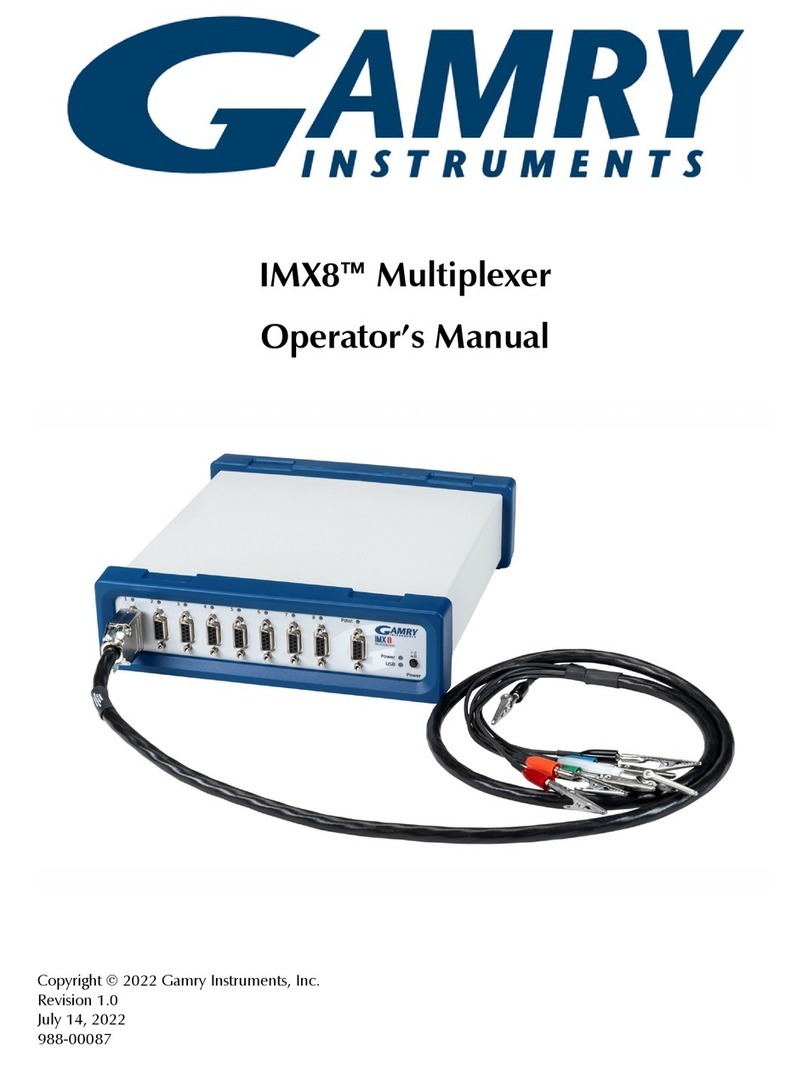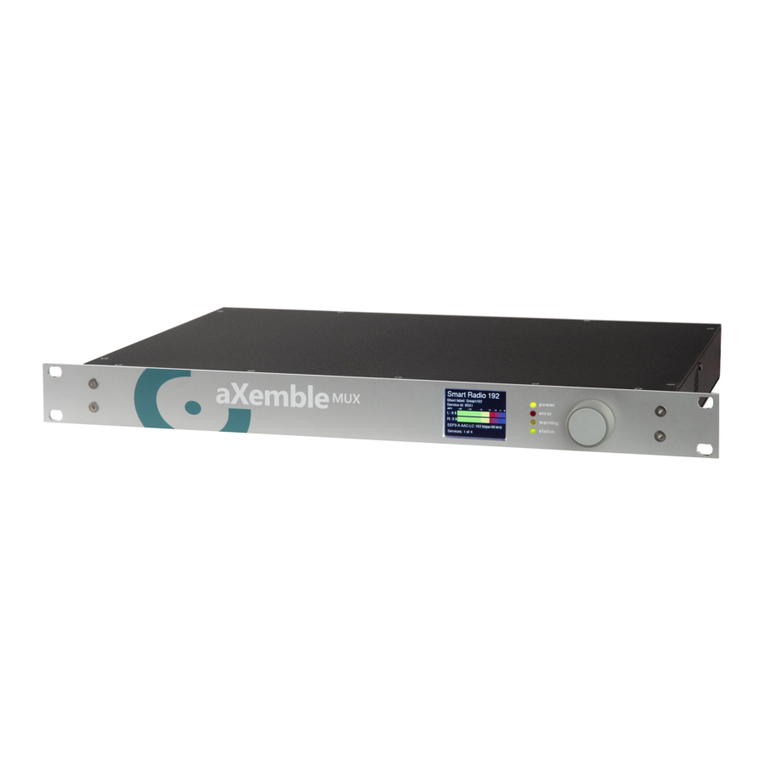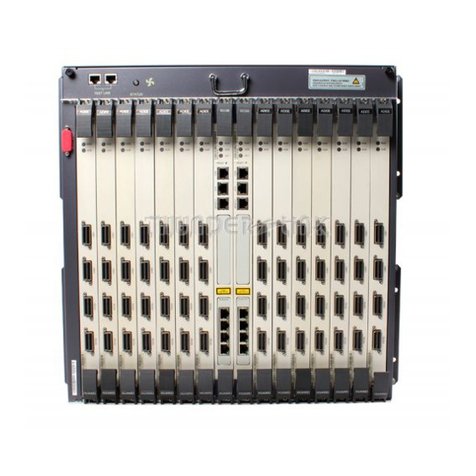Keithley 7708 User manual

Model 7708 40-Channel Differential Multiplexer
with Automatic CJC
User’s Guide
PA-744 Rev. C / 8-03
A GREATER MEASURE OF CONFIDENCE

WARRANTY
Keithley Instruments, Inc. warrants this product to be free from defects in material and workmanship for a period of 1 year
from date of shipment.
Keithley Instruments, Inc. warrants the following items for 90 days from the date of shipment: probes, cables, rechargeable
batteries, diskettes, and documentation.
During the warranty period, we will, at our option, either repair or replace any product that proves to be defective.
To exercise this warranty, write or call your local Keithley representative, or contact Keithley headquarters in Cleveland, Ohio.
You will be given prompt assistance and return instructions. Send the product, transportation prepaid, to the indicated service
facility. Repairs will be made and the product returned, transportation prepaid. Repaired or replaced products are warranted for
the balance of the original warranty period, or at least 90 days.
LIMITATION OF WARRANTY
This warranty does not apply to defects resulting from product modification without Keithley’s express written consent, or
misuse of any product or part. This warranty also does not apply to fuses, software, non-rechargeable batteries, damage from
battery leakage, or problems arising from normal wear or failure to follow instructions.
THIS WARRANTY IS IN LIEU OF ALL OTHER WARRANTIES, EXPRESSED OR IMPLIED, INCLUDING ANY
IMPLIED WARRANTY OF MERCHANTABILITY OR FITNESS FOR A PARTICULAR USE. THE REMEDIES PRO-
VIDED HEREIN ARE BUYER’S SOLE AND EXCLUSIVE REMEDIES.
NEITHER KEITHLEY INSTRUMENTS, INC. NOR ANY OF ITS EMPLOYEES SHALL BE LIABLE FOR ANY DIRECT,
INDIRECT, SPECIAL, INCIDENTAL OR CONSEQUENTIAL DAMAGES ARISING OUT OF THE USE OF ITS
INSTRUMENTS AND SOFTWARE EVEN IF KEITHLEY INSTRUMENTS, INC., HAS BEEN ADVISED IN ADVANCE
OF THE POSSIBILITY OF SUCH DAMAGES. SUCH EXCLUDED DAMAGES SHALL INCLUDE, BUT ARE NOT LIM-
ITED TO: COSTS OF REMOVAL AND INSTALLATION, LOSSES SUSTAINED AS THE RESULT OF INJURY TO ANY
PERSON, OR DAMAGE TO PROPERTY.
Keithley Instruments, Inc.
28775 Aurora Road • Cleveland, Ohio 44139 • 440-248-0400 • Fax: 440-248-6168
1-888-KEITHLEY (534-8453) • www.keithley.com
Sales Offices:
BELGIUM:
Bergensesteenweg 709 • B-1600 Sint-Pieters-Leeuw • 02-363 00 40 • Fax: 02-363 00 64
CHINA:
Yuan Chen Xin Building, Room 705 • 12 Yumin Road, Dewai, Madian • Beijing 100029 • 8610-82251886 • Fax: 8610-82251892
FINLAND:
Halsuantie 2 • 00420 Helsinki, Finland • 09-53 06 65 60 • Fax: 09-53 06 65 65
FRANCE:
3, allée des Garays • 91127 Palaiseau Cédex • 01-64 53 20 20 • Fax: 01-60 11 77 26
GERMANY:
Landsberger Strasse 65 • 82110 Germering • 089-84 93 07-40 • Fax: 089-84 93 07-34
GREAT BRITAIN:
Unit 2 Commerce Park, Brunel Road • Theale, Berkshire RG7 4AB • 0118 -929 75 00 • Fax: 0118- 929 75 19
INDIA:
1/5, Eagles Street • Langford Town • Bangalore 560 025 • 080 212 80-27 • Fax: 080 212 80 05
ITALY:
Viale San Gimignano, 38 • 20146 Milano • 02-48 39 16 01 • Fax: 02-48 30 22 74
JAPAN:
New Pier Takeshiba North Tower 13F • 11-1, Kaigan 1-chome • Minato-ku, Tokyo 105-0022 • 81-3-5733-7555 • Fax: 81-3-5733-7556
KOREA:
2FL., URI Building • 2-14 Yangjae-Dong • Seocho-Gu, Seoul 137-888 • 82-2-574-7778 • Fax: 82-2-574-7838
NETHERLANDS:
Postbus 559 • 4200 AN Gorinchem • 0183-63 53 33 • Fax: 0183-63 08 21
SWEDEN:
c/o Regus Business Centre • Frosundaviks Allé 15, 4tr • 16970 Solna • 08-50 90 46 00 • Fax: 08-655 26 10
TAIWAN:
13F-3, NO. 6, Lane 99, Pu-Ding Road, Hsinchu, Taiwan, ROC. • 886-3-572-9077 • Fax: 886-3-572-9031
5/03

Safety Precautions
The following safety precautions should be observed before using
this product and any associated instrumentation. Although some in-
struments and accessories would normally be used with non-haz-
ardous voltages, there are situations where hazardous conditions
may be present.
This product is intended for use by qualified personnel who recog-
nize shock hazards and are familiar with the safety precautions re-
quired to avoid possible injury. Read and follow all installation,
operation, and maintenance information carefully before using the
product. Refer to the manual for complete product specifications.
If the product is used in a manner not specified, the protection pro-
vided by the product may be impaired.
The types of product users are:
Responsible body
is the individual or group responsible for the use
and maintenance of equipment, for ensuring that the equipment is
operated within its specifications and operating limits, and for en-
suring that operators are adequately trained.
Operators
use the product for its intended function. They must be
trained in electrical safety procedures and proper use of the instru-
ment. They must be protected from electric shock and contact with
hazardous live circuits.
Maintenance personnel
perform routine procedures on the product
to keep it operating properly, for example, setting the line voltage
or replacing consumable materials. Maintenance procedures are de-
scribed in the manual. The procedures explicitly state if the operator
may perform them. Otherwise, they should be performed only by
service personnel.
Service personnel
are trained to work on live circuits, and perform
safe installations and repairs of products. Only properly trained ser-
vice personnel may perform installation and service procedures.
Keithley products are designed for use with electrical signals that
are rated Measurement Category I and Measurement Category II, as
described in the International Electrotechnical Commission (IEC)
Standard IEC 60664. Most measurement, control, and data I/O sig-
nals are Measurement Category I and must not be directly connect-
ed to mains voltage or to voltage sources with high transient over-
voltages. Measurement Category II connections require protection
for high transient over-voltages often associated with local AC
mains connections. Assume all measurement, control, and data I/O
connections are for connection to Category I sources unless other-
wise marked or described in the Manual.
Exercise extreme caution when a shock hazard is present. Lethal
voltage may be present on cable connector jacks or test fixtures. The
American National Standards Institute (ANSI) states that a shock
hazard exists when voltage levels greater than 30V RMS, 42.4V
peak, or 60VDC are present.
A good safety practice is to expect
that hazardous voltage is present in any unknown circuit before
measuring.
Operators of this product must be protected from electric shock at
all times. The responsible body must ensure that operators are pre-
vented access and/or insulated from every connection point. In
some cases, connections must be exposed to potential human con-
tact. Product operators in these circumstances must be trained to
protect themselves from the risk of electric shock. If the circuit is
capable of operating at or above 1000 volts,
no conductive part of
the circuit may be exposed.
Do not connect switching cards directly to unlimited power circuits.
They are intended to be used with impedance limited sources.
NEVER connect switching cards directly to AC mains. When con-
necting sources to switching cards, install protective devices to lim-
it fault current and voltage to the card.
Before operating an instrument, make sure the line cord is connect-
ed to a properly grounded power receptacle. Inspect the connecting
cables, test leads, and jumpers for possible wear, cracks, or breaks
before each use.
When installing equipment where access to the main power cord is
restricted, such as rack mounting, a separate main input power dis-
connect device must be provided, in close proximity to the equip-
ment and within easy reach of the operator.
For maximum safety, do not touch the product, test cables, or any
other instruments while power is applied to the circuit under test.
ALWAYS remove power from the entire test system and discharge
any capacitors before: connecting or disconnecting cables or jump-
ers, installing or removing switching cards, or making internal
changes, such as installing or removing jumpers.
Do not touch any object that could provide a current path to the com-
mon side of the circuit under test or power line (earth) ground. Always
make measurements with dry hands while standing on a dry, insulated
surface capable of withstanding the voltage being measured.
The instrument and accessories must be used in accordance with its
specifications and operating instructions or the safety of the equip-
ment may be impaired.
Do not exceed the maximum signal levels of the instruments and ac-
cessories, as defined in the specifications and operating informa-
tion, and as shown on the instrument or test fixture panels, or
switching card.
When fuses are used in a product, replace with same type and rating
for continued protection against fire hazard.
Chassis connections must only be used as shield connections for
measuring circuits, NOT as safety earth ground connections.
If you are using a test fixture, keep the lid closed while power is ap-
plied to the device under test. Safe operation requires the use of a
lid interlock.
5/03

If a screw is present, connect it to safety earth ground using the
wire recommended in the user documentation.
The symbol on an instrument indicates that the user should re-
fer to the operating instructions located in the manual.
The symbol on an instrument shows that it can source or mea-
sure 1000 volts or more, including the combined effect of normal
and common mode voltages. Use standard safety precautions to
avoid personal contact with these voltages.
The symbol indicates a connection terminal to the equipment
frame.
The
WARNING
heading in a manual explains dangers that might
result in personal injury or death. Always read the associated infor-
mation very carefully before performing the indicated procedure.
The
CAUTION
heading in a manual explains hazards that could
damage the instrument. Such damage may invalidate the warranty.
Instrumentation and accessories shall not be connected to humans.
Before performing any maintenance, disconnect the line cord and
all test cables.
To maintain protection from electric shock and fire, replacement
components in mains circuits, including the power transformer, test
leads, and input jacks, must be purchased from Keithley Instru-
ments. Standard fuses, with applicable national safety approvals,
may be used if the rating and type are the same. Other components
that are not safety related may be purchased from other suppliers as
long as they are equivalent to the original component. (Note that se-
lected parts should be purchased only through Keithley Instruments
to maintain accuracy and functionality of the product.) If you are
unsure about the applicability of a replacement component, call a
Keithley Instruments office for information.
To clean an instrument, use a damp cloth or mild, water based
cleaner. Clean the exterior of the instrument only. Do not apply
cleaner directly to the instrument or allow liquids to enter or spill
on the instrument. Products that consist of a circuit board with no
case or chassis (e.g., data acquisition board for installation into a
computer) should never require cleaning if handled according to in-
structions. If the board becomes contaminated and operation is af-
fected, the board should be returned to the factory for proper
cleaning/servicing.
!

PA-744 Rev. C / 8-03
Model 7708
40-Channel Differential Multiplexer with Automatic CJC
User’s Guide
Keithley Instruments, Inc.
28775 Aurora Road
Cleveland, Ohio 44139
(440) 248-0400
Fax: (440) 248-6168
www.keithley.com
Introduction
The Model 7708 is a 40-channel differential multiplexer card with the following features:
• DC and AC voltage measurement
• 2-wire or 4-wire
Ω
measurement (automatically pairs switches for four wire measurements —
n
+ 20)
• Temperature applications (RTD, thermistor, thermocouple)
• Built-in cold junction reference
• Screw terminal connections
• Designed specifically for use with Keithley’s Model 2700, 2701, and 2750 system DMMs.
NOTE
All references to the Model 27xx apply to the Models 2700, 2701, and 2750.
WARNING
Before operating the Model 27xx with an accessory card, verify that the card is properly
installed and the mounting screws are tightly fastened. If the mounting screws are not
properly connected, an electrical shock hazard may be present.
Topic Page
Introduction
Specifications ........................................................................................................................................................................ 2
Operating instructions........................................................................................................................................................... 2
Card configuration
Description............................................................................................................................................................................ 3
Card connections................................................................................................................................................................... 4
Wiring procedure .................................................................................................................................................................. 6
Typical connections .............................................................................................................................................................. 7
Connection log...................................................................................................................................................................... 9
Performance verification
Verification test requirements ............................................................................................................................................. 10
Test considerations.............................................................................................................................................................. 11
Verification limits................................................................................................................................................................ 11
Recommended test equipment ............................................................................................................................................ 12
Performance verification procedures .................................................................................................................................. 13
Calibration
Recommended test equipment ............................................................................................................................................ 23
Extender board connections................................................................................................................................................ 23
Model 7708 calibration....................................................................................................................................................... 23
Replaceable parts
Parts list............................................................................................................................................................................... 24
Ordering information .......................................................................................................................................................... 26
Factory service .................................................................................................................................................................... 26
Component layout............................................................................................................................................................... 26

2
Specifications
The specifications for the Model 7708 switching card are located at the end of this User’s Guide.
Operating instructions
Switching card operation is covered in the Model 27xx User’s Manual. The Model 7708 operates the same as the Model 7700
switching card with the following differences:
• The Model 7708 has 40 channels; the Model 7700 has 20 channels.
• The Model 7708 does not have any amps channels; the Model 7700 has two amps channels.
Amps measurements
The 7708 module does not support amps measurements. System channel operation cannot be used to close channels while an
amps function (DCI or ICI) is selected.
If an amps function (DCI or ACI) is selected and you attempt to close a system channel, the message “NO AMPS CHAN” will
be displayed briefly. For remote programming, error -222 (Parameter data out of range) is generated. Example:
SYST:PRES
‘ Restores system preset defaults.
SENS:FUNC ‘CURR:DC’
‘ Selects DCI function.
ROUT:CLOS (@101)
‘ Attempts to close system channel 101 – Generates error -222.
If a system channel is already closed and you attempt to select the DCI or ACI function, the message “INVALID FUNC” will
be displayed briefly. For remote programming, error -221 (Settings conflict) is generated. Example:
SYST:PRES
‘ Restores system preset defaults.
ROUT:CLOS (@101)
‘ Close system channel 101.
SENS:FUNC ‘CURR:DC’
‘ Attempts to select DCI function – Generates error -221.
Making amps measurements
– In order to perform amps measurements, you must use the front panel inputs of the 27xx main-
frame. You can still use the 7708 module for other aspects of the test (such as controlling a bias supply for DUT), but you must
use multiple channel operation to close channels. Example:
NOTE
In order to use the front panel inputs, make sure the INPUT switch is in the out (F) position.
SYST:PRES
‘ Restores system preset defaults.
ROUT:MULT:CLOS (@101)
‘ Closes channel 101.
SENS:FUNC ‘CURR:DC’
‘ Selects DCI function – Legal operation.

3
Card configuration
Description
Figure 1 shows a simplified schematic diagram of the Model 7708 module. As shown, the Model 7708 has channels that are
grouped into two banks of twenty channels (forty channels total). Backplane isolation is provided for each bank. Each bank also
includes separate cold junction reference points. The first bank contains channels 1 through 20 while the second bank contains
channels 21 through 40. Each channel of the 40-channel multiplexer card is wired with separate inputs for HI/LO providing
fully isolated inputs.
Although the Model 7708 relays are the latching type (relays hold their state even after power has been removed), all relay states
are set to open a few seconds after either a power cycle or a *RST command is issued.
Connections to DMM functions are provided through the card backplane connector.
Figure 1
Simplified schematic of Model 7708
NOTES:
Channels 4143 in this schematic refer to the designations
used for control and not actual available channels.
Channels 42 and 43 can be individually controlled using
multiple channel operation (ROUT:MULT commands) if
the module is not to be connected to the internal D .
For more information on multiple channel operation, see
Section 2 of the odel 27xx Users anual.
Cold junction
Ref x4
Channel 1 HI
LO
Channel 20
HI
LO
(Channels 219)
Channel 21 HI
LO
Channel 40
HI
LO
(Channels 2239)
HI
LO
Sense
HI
LO
Input
Channel 41
2-Pole (Open)
4-Pole (Closed)
(see Notes)
To odel 27xx
Backplane
Channel 43
(see Note)
Backplane
isolation
Channel 42
(see Note)
Backplane
isolation
Sense HI
LO
Input HI
LO
Cold junction
Ref x5

4
Channel 41 (2W/4W Configuration), Channel 42 (Sense Isolation), and Channel 43 (Input Isolation) are normally automatically
configured by the Model 27xx. However, by using the
:ROUT:MULT:
commands (refer to Section 2 of the Model 27xx User’s
Manual), they can be manually configured.
NOTE
Connect 4-wire sense leads using channels 21–40.
To disconnect channels 21–40 from channels 1–20, send:
:ROUT:MULT:CLOS (@141) (
note opposite logic).
When automatically configured for 4-wire measurements (including 4-wire
Ω
, RTD temperature, Ratio, and Channel average)
the channels are paired as follows:
Card connections
WARNING
The information in this section is intended for qualified service personnel. Do not
attempt to perform this procedure unless qualified to do so.
Figure 2 shows how to access the screw terminals on the Model 7708. Channel designations for the screw terminals are
contained in Figure 3.
WARNING
Do not exceed the maximum specifications for the Model 7708 module. Refer to the end
of this packing list for specifications.
Figure 2
Screw terminal access
• CH1 and CH21 • CH8 and CH28 • CH15 and CH35
• CH2 and CH22 • CH9 and CH29 • CH16 and CH36
• CH3 and CH23 • CH10 and CH30 • CH17 and CH37
• CH4 and CH24 • CH11 and CH31 • CH18 and CH38
• CH5 and CH25 • CH12 and CH32 • CH19 and CH39
• CH6 and CH26 • CH13 and CH33 • CH20 and CH40
• CH7 and CH27 • CH14 and CH34
H L
CH1
H L
CH2
H L
CH3
H L
CH4
H L
CH5
H L
CH6
H L
CH7
H L
CH8
H L
CH9 H L
CH10
H L
CH11
H L
CH12
H L
CH13
H L
CH14
U
N
L
O
C
K
LOCK
H L
INPUT
CH15
H L CH16
H L CH17
H L CH18
H L CH19
H L CH20
H L CH35
H L CH36
H L CH37
H L
CH38
H L CH39
H L
CH40
H L
CH21
H L CH22
H L CH23
H L CH24
H L CH25
H L CH26
H L CH27
H L CH28
H L CH29
H L CH30
H L CH31
H L CH32
H L CH33
H L CH34
H L
H L
SENSE

5
Figure 3
Model 7708 screw terminal channel designations
H L
INPUT
CH15
H L CH16
H L CH17
H L CH18
H L CH19
H L CH20
H L CH35
H L CH36
H L CH37
H L
CH38
H L CH39
H L
CH40
H L
CH21
H L CH22
H L CH23
H L CH24
H L CH25
H L CH26
H L CH27
H L CH28
H L CH29
H L CH30
H L CH31
H L CH32
H L CH33
H L CH34
H L
H L
SENSE
Cable tie holes
Cable tie holes
H L
CH1
H L
CH2
H L
CH3
H L
CH4
H L
CH5
H L
CH6
H L
CH7
H L
CH8
H L
CH9 H L
CH10
H L
CH11
H L
CH12
H L
CH13
H L
CH14
CH20
H L
CH15
H L thru CH40
H L
CH35
H L thru
CH14
H L
CH1
H L thru
CH34
H L
CH21
H L thru
SENSE
H L
INPUT
H L
and

6
Wiring procedure
WARNING
The information in this section is intended for qualified service personnel. Do not
attempt to perform this procedure unless qualified to do so.
Use the following procedure to wire the Model 7708 module. Make all connections using the correct wire size (up to 20 AWG).
Also, make sure to add supplementary insulation around the harness for voltages above 42V peak (see Figure 4).
WARNING
All wiring and supplementary insulation must be rated for the maximum voltage in the
system. For example, if 1000V is applied to the front terminals of the Model 27xx, the
plug-in module wiring must be rated for 1000V.
1. Make sure all power is discharged from the Model 7708 module.
2. Access the screw terminals (see Figure 2).
3. Using a small flat-blade screwdriver, loosen terminal screws and install wires as desired. (Figure 4 shows connections to
channels 1 and 2.)
4. Route wire along wire-path and secure with cable ties as shown.
5. Fill in a copy of the connection log (Table 1) and affix it to the module cover.
6. Close and lock cover.
Figure 4
Wire dressing
CH16
H L
Supplementary
Insulation
H L
INPUT
CH15
H L CH17
H L CH18
H L CH19
H L CH20
H L CH35
H L CH36
H L CH37
H L
CH38
H L CH39
H L
CH40
H L
CH21
H L CH22
H L CH23
H L CH24
H L CH25
H L CH26
H L CH27
H L CH28
H L CH29
H L CH30
H L CH31
H L CH32
H L CH33
H L CH34
H L
H L
SENSE
CH16
H L
CH15
H L CH17
H L CH18
H L
H L
CH1
H L
CH2
H L
CH3
H L
CH4
H L
CH5
H L
CH6
H L
CH7
H L
CH8
H L
CH9 H L
CH10
H L
CH11
H L
CH12
H L
CH13
H L
CH14
Cable path
for channels 1
through 20
Cable path
for channels 21
through 40
Cable Tie
H L
CH1
H L
CH2
H L
CH3
H L
CH4

7
Typical connections
The following examples show typical wiring connections for the following types of measurements:
• Thermocouple connections, see Figure 5
•
Ω
2-wire and thermistor connections, see Figure 6
•
Ω
4-wire and RTD connections, see Figure 7
• Voltage (AC or DC), see Figure 8
Figure 5
Thermocouple connections
Figure 6
Ω
2-wire and thermistor connections
Channel 1
HI
LO
Channel 40
HI
LO
(Channels 2–39) Thermocouples
Channel 1
HI
LO
Channel 40
HI
LO
(Channels 2–39) Resistors or
Thermistors

8
Figure 7
Ω
4-wire and RTD connections
Figure 8
Voltage connections (DC or AC)
Channel 1
HI
LO
Channel 20
HI
LO
(Channels 2–19)
Channel 21
HI
LO
Channel 40
HI
LO
(Channels 22–39)
Resistor or
4-Wire RTD
Resistor or
4-Wire RTD
Channel 1
HI
LO
Channel 40
HI
LO
(Channels 2–39)
+
+
DC Voltage AC Voltage

9
Connection log
Make a copy of Table 1 and affix it to the cover of the Model 7708. Use this to record connection information and channel
descriptions as needed.
Table 1
Connection log Model 7708
Channel Color Description Description Color Channel
INPUT H
L
SENSE H
L
CH1 HH
CH21
LL
CH2 HH
CH22
LL
CH3 HH
CH23
LL
CH4 HH
CH24
LL
CH5 HH
CH25
LL
CH6 HH
CH26
LL
CH7 HH
CH27
LL
CH8 HH
CH28
LL
CH9 HH
CH29
LL
CH10 HH
CH30
LL
CH11 HH
CH31
LL
CH12 HH
CH32
LL
CH13 HH
CH33
LL
CH14 HH
CH34
LL
CH15 HH
CH35
LL
CH16 HH
CH36
LL
CH17 HH
CH37
LL
CH18 HH
CH38
LL
CH19 HH
CH39
LL
CH20 HH
CH40
LL

10
Performance verification
The performance of the Model 7708 card is tested by verifying measurement accuracy through the card. If verification limits
are met through the front panel terminals of the Model 27xx, they should also be met through the card.
WARNING
The information in this section is intended only for qualified service personnel. Do not
attempt these procedures unless you are qualified to do so.
NOTES
Measurement accuracy through the Model 7708 card should only be verified after instrument
accuracy has already been verified through the front panel terminals of the Model 27xx. The
procedures to verify accuracy from the front panel inputs are provided in the Model 2700 Service
Manual.
If the Model 7708 card is still under warranty and is the cause of measurement inaccuracy, contact
your Keithley representative or the factory to determine the correct course of action.
Model 7708 verification test procedures include:
• DC volts
• AC volts
• Resistance
• Temperature
• Frequency
• Ratio and average
Verification test requirements
Be sure that you perform the verification tests:
• Under the proper environmental conditions.
• After the specified warm-up period.
• Using the correct line voltage.
• After restoring factory defaults.
• With the INPUTS switch in the REAR (in) position.
Also, make sure to use the proper calibration equipment (Table 2) and the reading limits provided with the verification
procedures.
Environmental conditions
Conduct your performance verification procedures in a test environment that has:
• An ambient temperature of 18° to 28°C (65° to 82°F).
• A relative humidity of less than 80% unless otherwise noted.
Warm-up period
Allow the Model 27xx to warm up for at least two hours before conducting the verification procedures.
If the instrument has been subjected to temperature extremes (those outside the ranges stated above), allow additional time for
the instrument’s internal temperature to stabilize. Typically, allow one extra hour to stabilize a unit that is 10°C (18°F) outside
the specified temperature range.
Also, allow the test equipment to warm up for the minimum time specified by the manufacturer.

11
Line power
The Model 27xx requires a line voltage of 100V/120V/220V/240V, ±10% and a line frequency of 47.5Hz to 63Hz. Note
that the line frequency is automatically sensed at power-up, but the line voltage must be manually set to either 100V/120V or
220V/240V as described in Section 3 of the Model 27xx Service Manual.
Factory defaults
Before performing the verification procedures, restore the instrument to its factory defaults as follows:
1. Press SHIFT and then SETUP. The instrument will display the following prompt:
RESTORE: FACT.
2. Using either range key, select FACT, then restore the factory default conditions by pressing ENTER.
INPUTs switch
In order to connect the Model 7708 card to the meter of the Model 27xx, the INPUTs switch must be in the REAR (in) position.
The INPUTS switch is located on the front panel of the Model 27xx multimeter near the input terminals.
Test considerations
When performing the verification procedures:
• Be sure to restore factory defaults as outlined above.
• Make sure that the equipment is properly warmed up and connected to the correct input terminals. Also make sure that
the INPUTS switch is in the REAR (in) position.
• Do not use autoranging for any verification tests because autorange hysteresis may cause the Model 27xx to be on an
incorrect range. For each test signal, you must manually set the correct range for the Model 27xx using the range keys.
• Make sure the calibrator is in operate before you verify each measurement.
• Always let the source signal settle before taking a reading.
WARNING
Observe the following safety precautions when performing these tests:
• Some of the procedures in this section may expose you to dangerous voltages. Use
standard safety precautions when such dangerous voltages are encountered to avoid
personal injury or death caused by electric shock.
• The maximum common-mode voltage (voltage between any plug-in module terminal
and chassis ground) is 300V DC or 300V RMS. Exceeding this value may cause a
breakdown in insulation, creating a shock hazard.
Verification limits
The verification limits stated in this section have been calculated using only the Model 27xx one-year accuracy specifications,
and they do not include test equipment uncertainty. If a particular measurement falls slightly outside the allowable range,
recalculate new limits based on both Model 27xx specifications and pertinent calibration equipment specifications.

12
Example reading limit calculation
The following is an example of how reading limits have been calculated. Assume you are testing the 10V DC range using a 10V
input value. Using the Model 27xx one-year accuracy specification for 10V DC of ± (30ppm of reading + 5ppm of range), the
calculated limits are:
Reading limits = 10V ± [(10V
×
30ppm) + (10V
×
5ppm)]
Reading limits = 10V ± (0.0003 + 0.00005)
Reading limits = 10V ± 0.00035V
Reading limits = 9.99965V to 10.00035V
Calculating resistance reading limits
Resistance reading limits must be recalculated based on the actual calibration resistance values supplied by the equipment
manufacturer. Calculations are performed in the same manner as shown in the preceding example, except, of course, that you
should use the actual calibration resistance values instead of the nominal values when performing your calculations.
For example, assume that you are testing the 10k
Ω
range using an actual 10.03k
Ω
calibration resistance value. Using
Model 27xx one-year 10k
Ω
range accuracy of ± (100ppm of reading + 6ppm of range), the calculated reading limits are:
Reading limits = 10.03k
Ω
± [(10.03k
Ω
×
100ppm) + (10k
Ω
×
6ppm)]
Reading limits = 10.02894k
Ω
to 10.03106k
Ω
Recommended test equipment
Table 2 summarizes recommended verification equipment. You can use alternate equipment as long as that equipment has
specifications at least as good as those listed in Table 2. Keep in mind, however, that calibrator uncertainty will add to the
uncertainty of each measurement.
Table 2
Recommended verification equipment
Fluke 5700A Calibrator:
DC voltage AC voltage (1kHz, 50kHz) Resistance
100mV:±14ppm
1.0V:±7ppm
10V:±5ppm
100V:±7ppm
1000V:±9ppm
100mV:±200ppm
1.0V:±82ppm
10V:±82ppm
100V:±90ppm
700V:±85ppm
100
Ω
:±17ppm
1k
Ω
:±12ppm
10k
Ω
:±11ppm
100k
Ω
:±13ppm
1M
Ω
:±18ppm
10M
Ω
:±37ppm
100M
Ω
:±120ppm
Fluke 5725A Amplifier:
AC Voltage, 50kHz: 700V, ±375ppm
Keithley 3930A or 3940 Frequency Synthesizer:
1V RMS, 10V RMS, 1kHz, ±5ppm, steady state and burst modulation
General Radio 1433-T Precision Decade Resistance Box:
10
Ω
to 400
Ω
, ±0.02%
Miscellaneous Equipment:
Double banana plug to double banana plug shielded cables (2)
BNC to double banana plug shielded cable
NOTE: The Fluke 5725A amplifier is necessary only if you wish to verify the 750V AC range at 50kHz. Verification at
220V and 50kHz using only the 5700A calibrator is adequate for most applications.

13
Performance verification procedures
NOTE
The following procedures check one channel (CH1) or one channel pair (CH1 and CH21) of the
Model 7708 card. To check other channels (or channel pairs), modify the procedures by connect-
ing the verification equipment to the appropriate channel (or channel pair) and then closing that
channel.
Verifying DC voltage
Check DC voltage accuracy by applying accurate voltages from the DC voltage calibrator to the Model 7708 input terminals
and verifying that the displayed readings fall within specified limits.
CAUTION
Do not exceed 300V DC between plug-in module INPUT H and L terminals or between
any adjacent channels.
Follow these steps to verify DC voltage accuracy:
1. Connect the Model 7708 CH1 H and L INPUT terminals to the DC voltage calibrator as shown in Figure 9.
NOTE
Use shielded, low-thermal connections when testing the 100mV and 1V ranges to avoid errors
caused by noise or thermal effects. Connect the shield to the calibrator’s output LO terminal.
Figure 9
Connections for DC volts verification
2. Install the Model 7708 in Slot 1 of the Model 27xx, turn on the power, and allow the unit to warm up for two hours before
proceeding. Be sure the front panel INPUTS switch is set to the REAR position.
H L
INPUT
CH15
H L CH16
H L CH17
H L CH18
H L CH19
H L CH20
H L CH35
H L CH36
H L CH37
H L
CH38
H L CH39
H L
CH40
H L
CH21
H L CH22
H L CH23
H L CH24
H L CH25
H L CH26
H L CH27
H L CH28
H L CH29
H L CH30
H L CH31
H L CH32
H L CH33
H L CH34
H L
H L
SENSE
H L
CH1
CH1
H L
CH2
CH15 CH16 CH
H L
CH1
H L
CH2
Output
HI
Output
LO
Calibrator (Output DC Voltage)
Model 7708
Note: Use shielded, low-thermal cables
for 100mV and 1V ranges.
H L
CH3
H L
CH5
H L
CH6
H L
CH7
H L
CH8
H L
CH9 H L
CH10
H L
CH11
H L
CH12
H L
CH13
H L
CH14
H L
CH4

14
3. Select the DC volts function by pressing the DCV key, and set the Model 27xx to the 100mV range. Close Channel 1 by
pressing the CLOSE key and then keying in 101.
4. Set the calibrator output to 0.00000mV DC, and allow the reading to settle.
5. Enable the Model 27xx REL mode. Leave REL enabled for the remainder of the DC volts verification tests.
6. Source positive and negative and full-scale voltages for each of the ranges listed in Table 3. For each voltage setting, be
sure that the reading is within stated limits.
7. Press the OPEN key to open Channel 1.
Verifying AC voltage
Check AC voltage accuracy by applying accurate AC voltages at specific frequencies from the AC voltage calibrator to the
Model 7708 inputs and verifying that the displayed readings fall within specified ranges.
CAUTION
Do not exceed 300V RMS between plug-in module INPUT H and L terminals or
between adjacent channels, or 8
×
10
7
V•Hz input, because instrument damage may
occur.
Follow these steps to verify AC voltage accuracy:
1. Connect the Model 7708 CH1 H and L INPUT terminals to the AC voltage calibrator as shown in Figure 10.
2. Install the Model 7708 in Slot 1 of the Model 27xx, turn on the power, and allow the unit to warm up for two hours before
proceeding. Be sure the front panel INPUTS switch is set to the REAR position.
3. Select the AC volts function by pressing the ACV key. Close Channel 1 by pressing the CLOSE key and then keying in
101.
Table 3
DCV reading limits
Range Applied DC voltage* Reading limits (1 year, 18° to 28°C)
100mV
1V
10V
100V
1000V
100.0000mV
1.000000V
10.00000V
100.0000V
300.000V
99.9925 to 100.0075mV
0.999962 to 1.000038V
9.99965 to 10.00035V
99.9946 to 100.0054V
299.976 to 300.024V
*Source positive and negative values for each range.

15
Figure 10
Connections for AC volts verification
4. Set the Model 27xx for the 100mV range; make sure that REL is disabled.
5. Source 1kHz and 50kHz AC voltages for each of the ranges summarized in Table 4, and make sure that the respective
Model 27xx readings fall within stated limits.
6. Press the OPEN key to open Channel 1.
Table 4
ACV reading limits
ACV range Applied AC voltage
1kHz reading limits
(1 year, 18°C to 28°C)
50kHz reading limits
(1 year, 18°C to 28°C)
100mV
1V
10V
100V
750V
100.0000mV
1.000000V
10.00000V
100.0000V
300.000V*
99.910 to 100.090mV
0.99910 to 1.00090V
9.9910 to 10.0090V
99.910 to 100.090V
299.60 to 300.40V
99.830 to 100.170mV
0.99830 to 1.00170V
9.98300 to 10.0170V
99.830 to 100.170V
299.27 to 300.73V
* If the 5725A amplifier is not available, change the 300V @ 50kHz step to 220V @ 50kHz. Reading limits for
220V @ 50kHz = 219.36 to 220.64V.
H L
INPUT
CH15
H L CH16
H L CH17
H L CH18
H L CH19
H L CH20
H L CH35
H L CH36
H L CH37
H L
CH38
H L CH39
H L
CH40
H L
CH21
H L CH22
H L CH23
H L CH24
H L CH25
H L CH26
H L CH27
H L CH28
H L CH29
H L CH30
H L CH31
H L CH32
H L CH33
H L CH34
H L
H L
SENSE
H L
CH1
CH1
H L
CH2
CH15 CH16 CH
H L
CH1
H L
CH2
Output
HI
Output
LO
Calibrator (Output AC Voltage)
Amplifier (Connect to Calibrator)
Shielded
Cable
Model 7708
H L
CH3
H L
CH5
H L
CH6
H L
CH7
H L
CH8
H L
CH9 H L
CH10
H L
CH11
H L
CH12
H L
CH13
H L
CH14
H L
CH4

16
Verifying resistance
Check resistance by connecting accurate resistance values to the Model 7708 and verifying that its resistance readings are within
the specified limits.
CAUTION Do not apply more than 300V between plug-in module INPUT or SENSE H and L
terminal, or between any adjacent channels, or instrument damage could occur.
Follow these steps to verify resistance accuracy:
1. Using shielded Teflon or equivalent cables in a 4-wire configuration, connect the Model 7708 CH1 H and L INPUT termi-
nals, and CH21 H and L SENSE terminals to the calibrator as shown in Figure 11.
2. Install the Model 7708 in Slot 1 of the Model 27xx, turn on the power, and allow the unit to warm up for two hours before
proceeding. Be sure the front panel INPUTS switch is set to the REAR position.
3. Set the calibrator for 4-wire resistance with external sense on.
4. Select the Model 27xx 4-wire resistance function by pressing the Ω4 key. Close Channel 1 by pressing the CLOSE key
and keying in 101.
Figure 11
Connections for resistance verification (100Ωto 10MΩ) ranges)
H L
INPUT
CH15
H L CH16
H L CH17
H L CH18
H L CH19
H L CH20
H L CH35
H L CH36
H L CH37
H L
CH38
H L CH39
H L
CH40
H L
CH21
H L CH22
H L CH23
H L CH24
H L CH25
H L CH26
H L CH27
H L CH28
H L CH29
H L CH30
H L CH31
H L CH32
H L CH33
H L CH34
H L
H L
SENSE
CH1
CH21
H L
CH1
H L
CH2
Output
HI
Output
LO
Resistance Calibrator
Note: Use shielded, low-thermal cables
to minimize noise. Enable or disable
calibrator external sense as indicated
in procedure.
Model 7708
Sense
HI
Sense
LO
H L
CH1
H L
CH2
CH21
H L CH22
H L
H L
CH3
H L
CH5
H L
CH6
H L
CH7
H L
CH8
H L
CH9 H L
CH10
H L
CH11
H L
CH12
H L
CH13
H L
CH14
H L
CH4
Table of contents
Other Keithley Multiplexer manuals
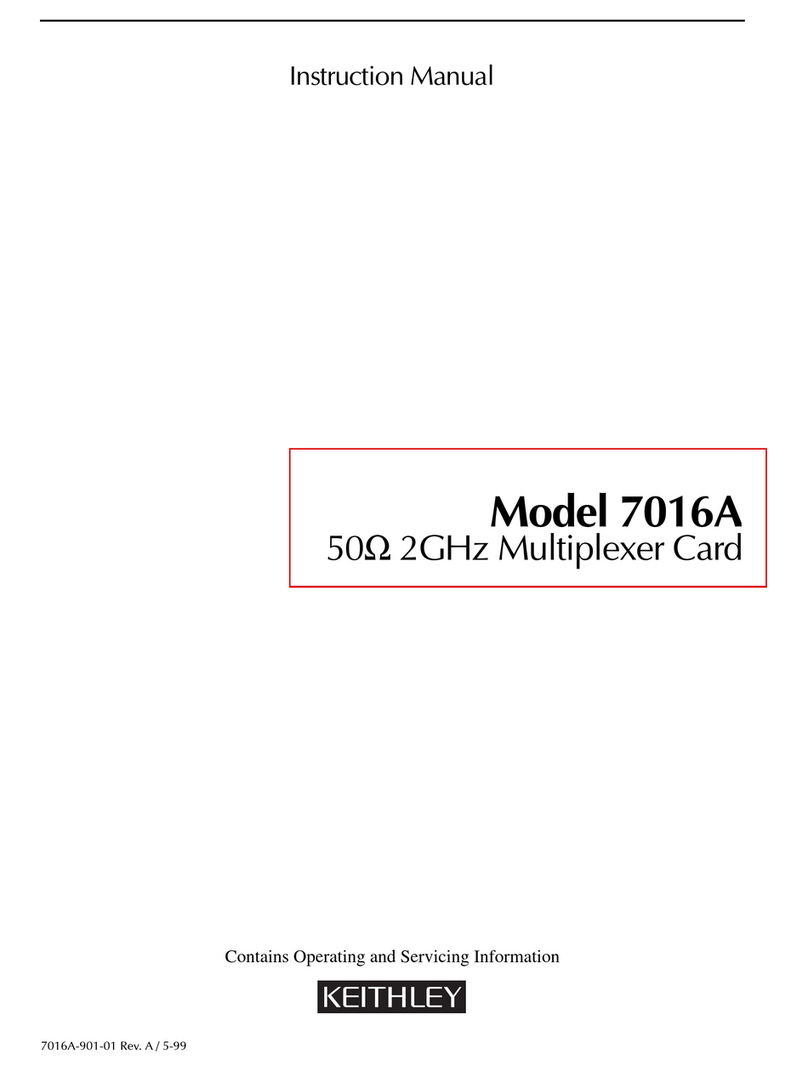
Keithley
Keithley 7016A User manual

Keithley
Keithley 7015-S User manual

Keithley
Keithley 7014 User manual

Keithley
Keithley 7701 User manual
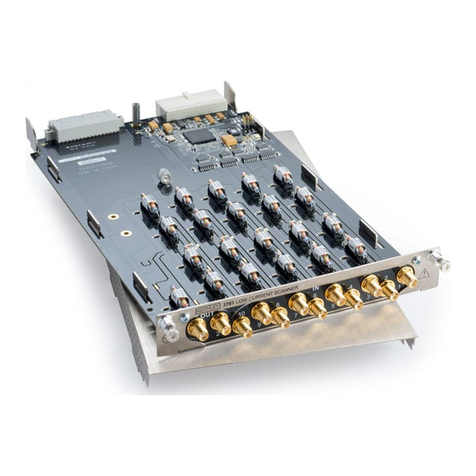
Keithley
Keithley 3761 User manual

Keithley
Keithley 7711 User manual
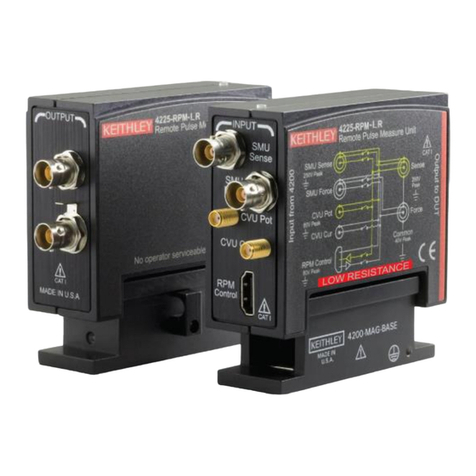
Keithley
Keithley 4225-RPM User manual

Keithley
Keithley EXP-16 User manual
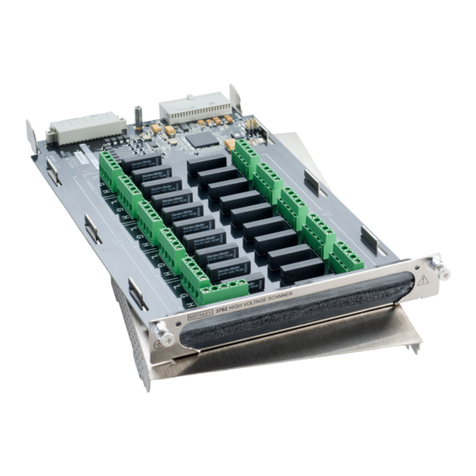
Keithley
Keithley 3706A User manual

Keithley
Keithley 7706 User manual
Popular Multiplexer manuals by other brands

Lucent Technologies
Lucent Technologies Metropolis DMXtend installation manual
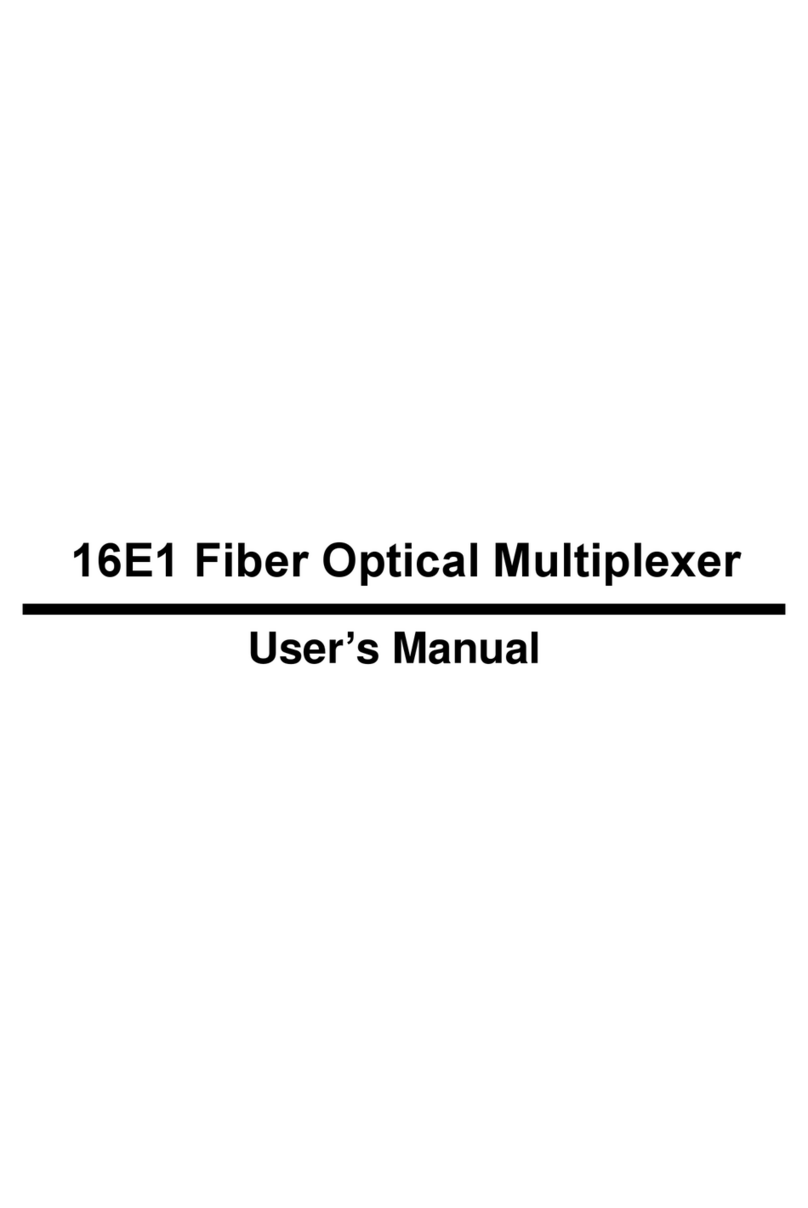
Techroutes
Techroutes 16E1 user manual
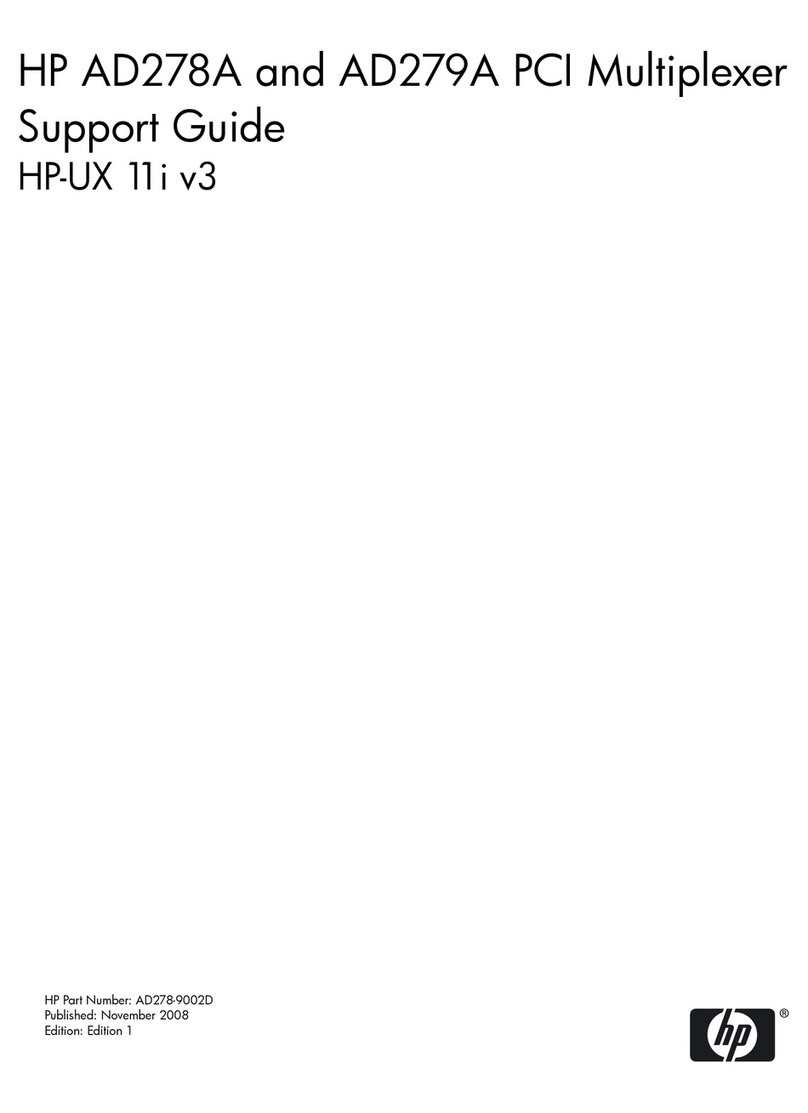
HP
HP AD278A Support guide
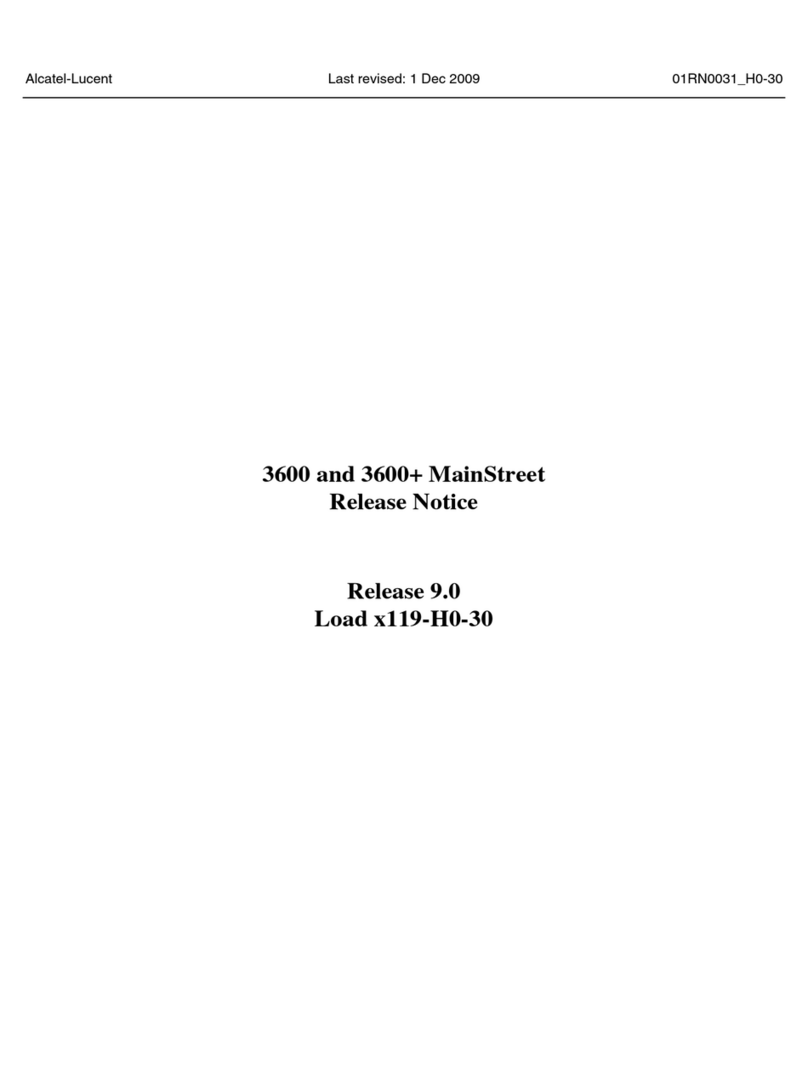
Alcatel-Lucent
Alcatel-Lucent 3600 MainStreet Release notice

Signametrics Corporation
Signametrics Corporation SM4020 Operator's manual
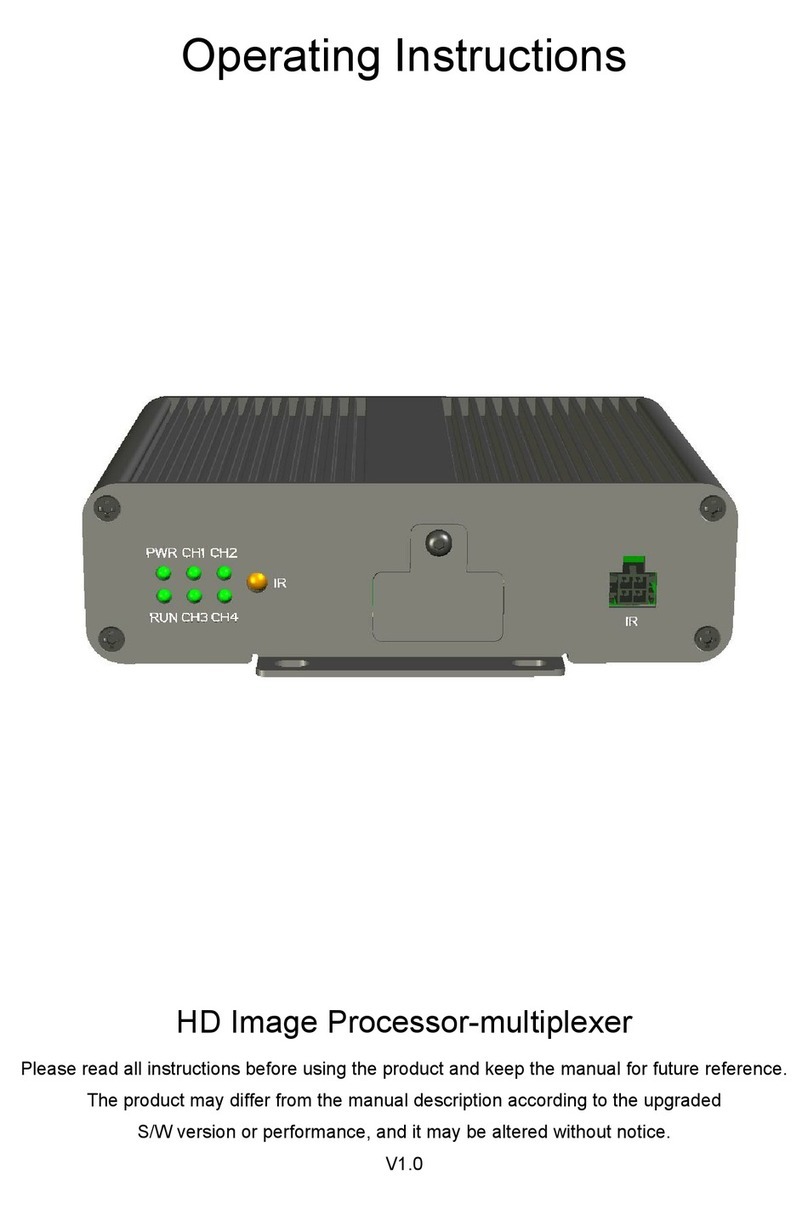
Krautli
Krautli EYESYSTEM RVA 318HD operating instructions

